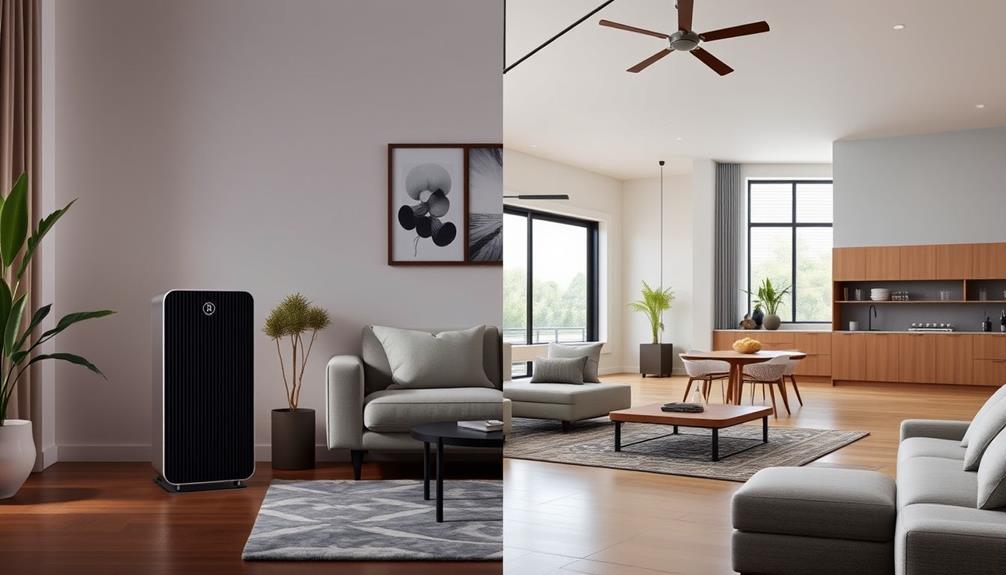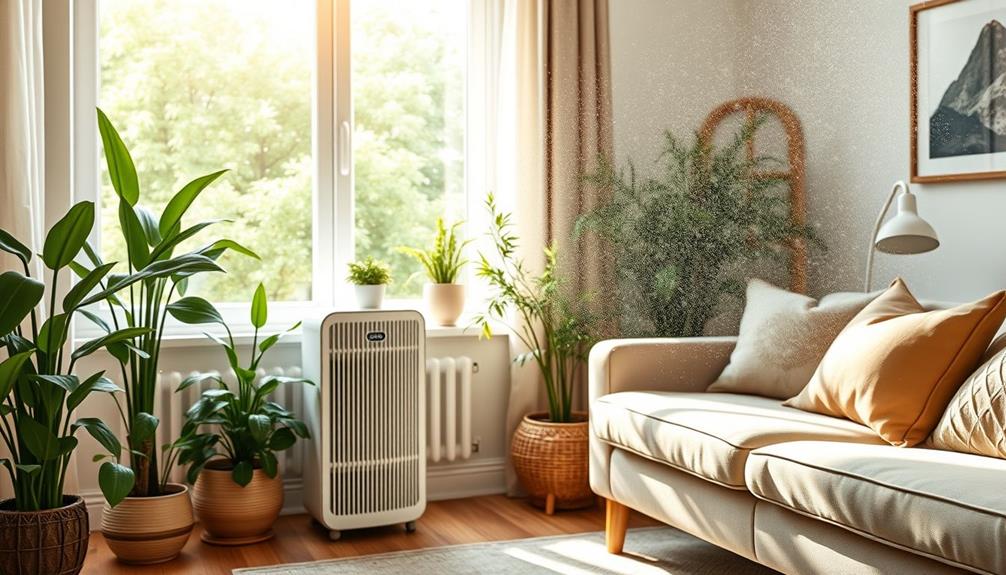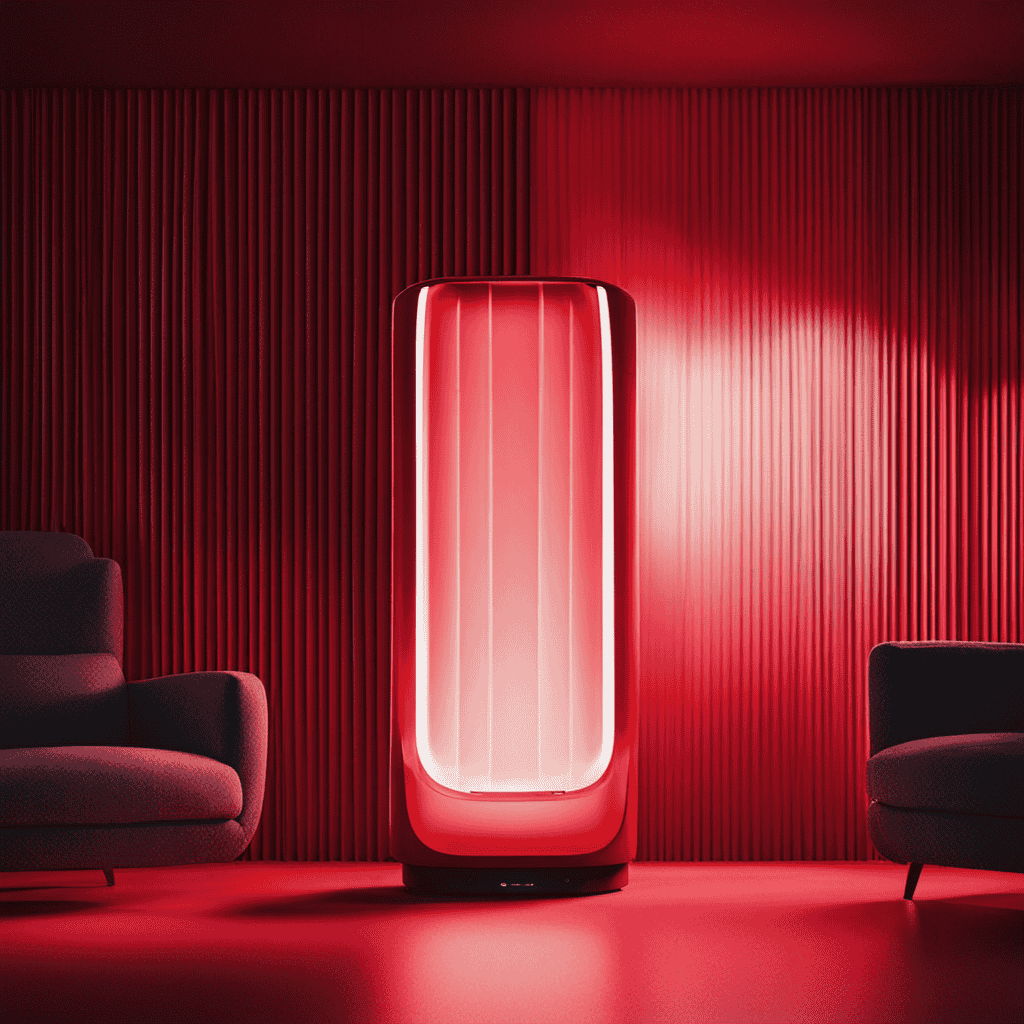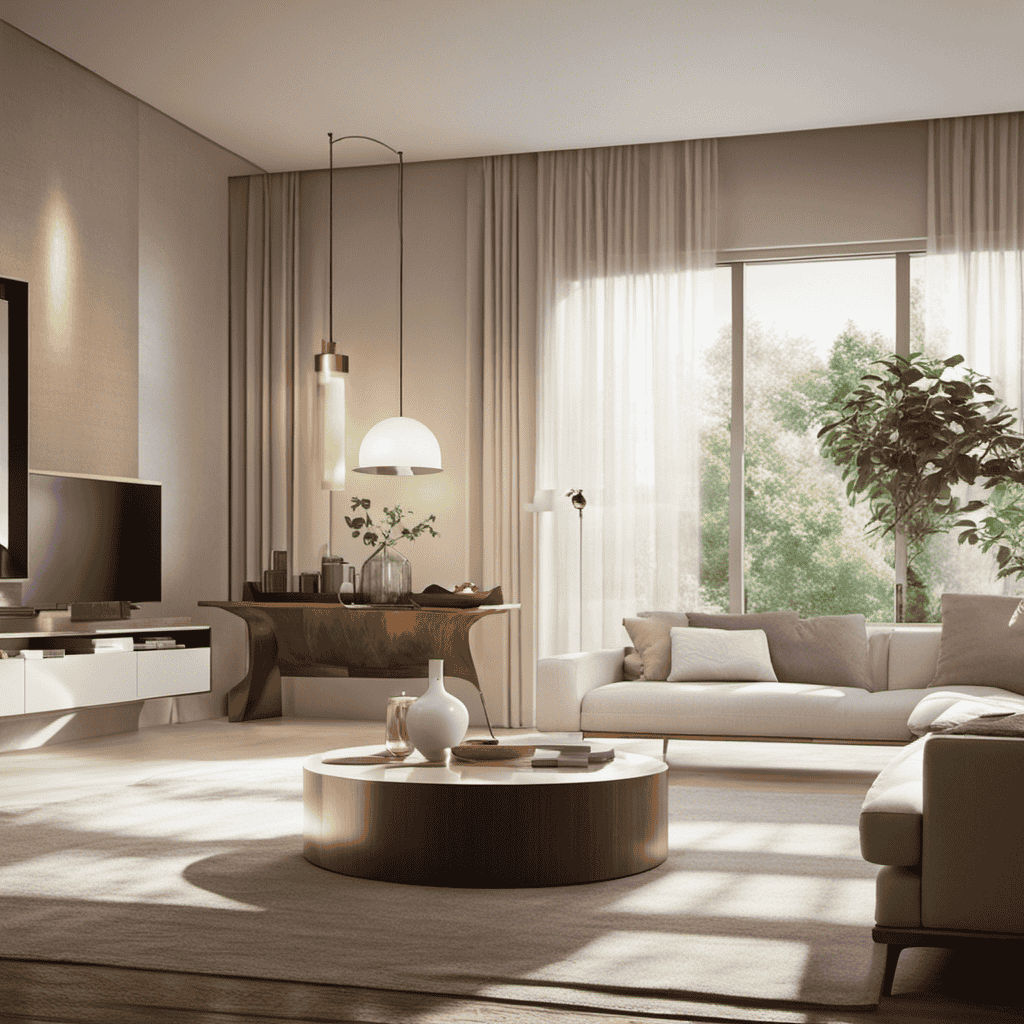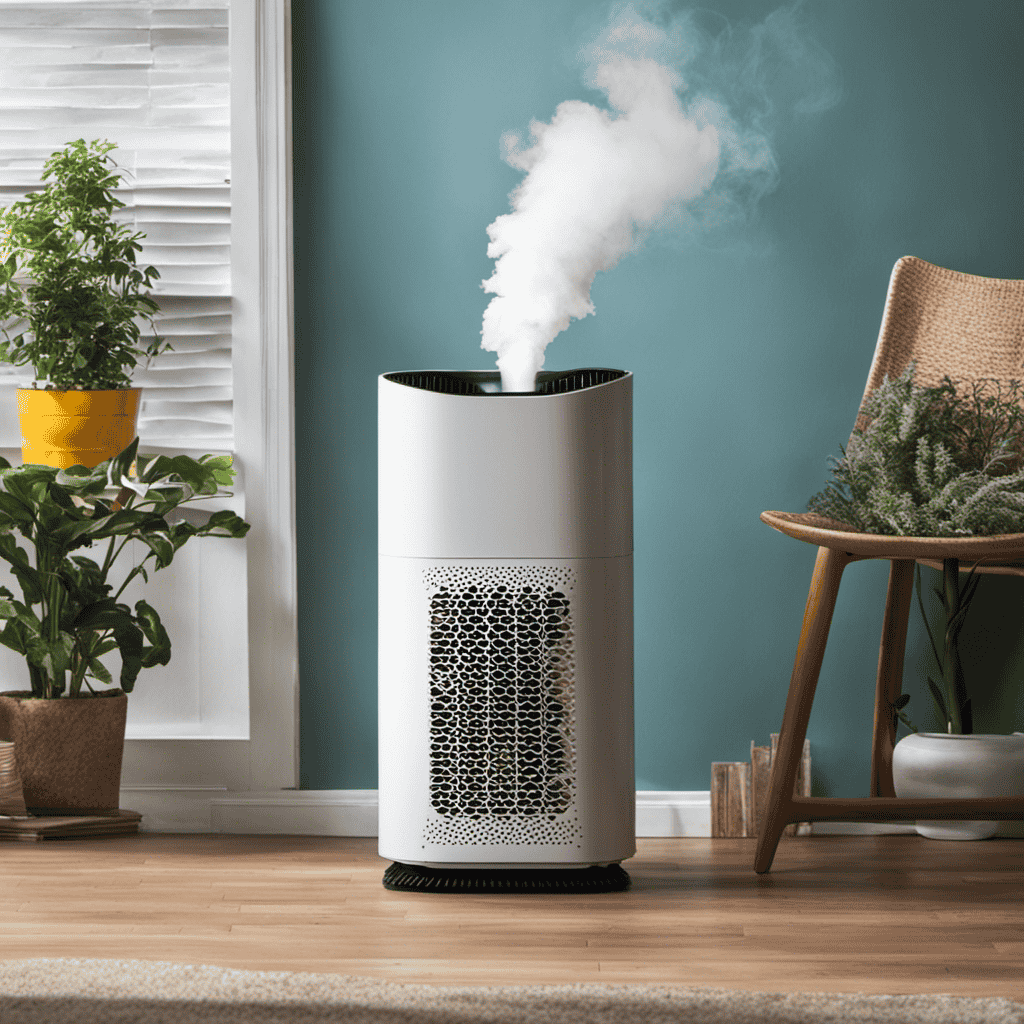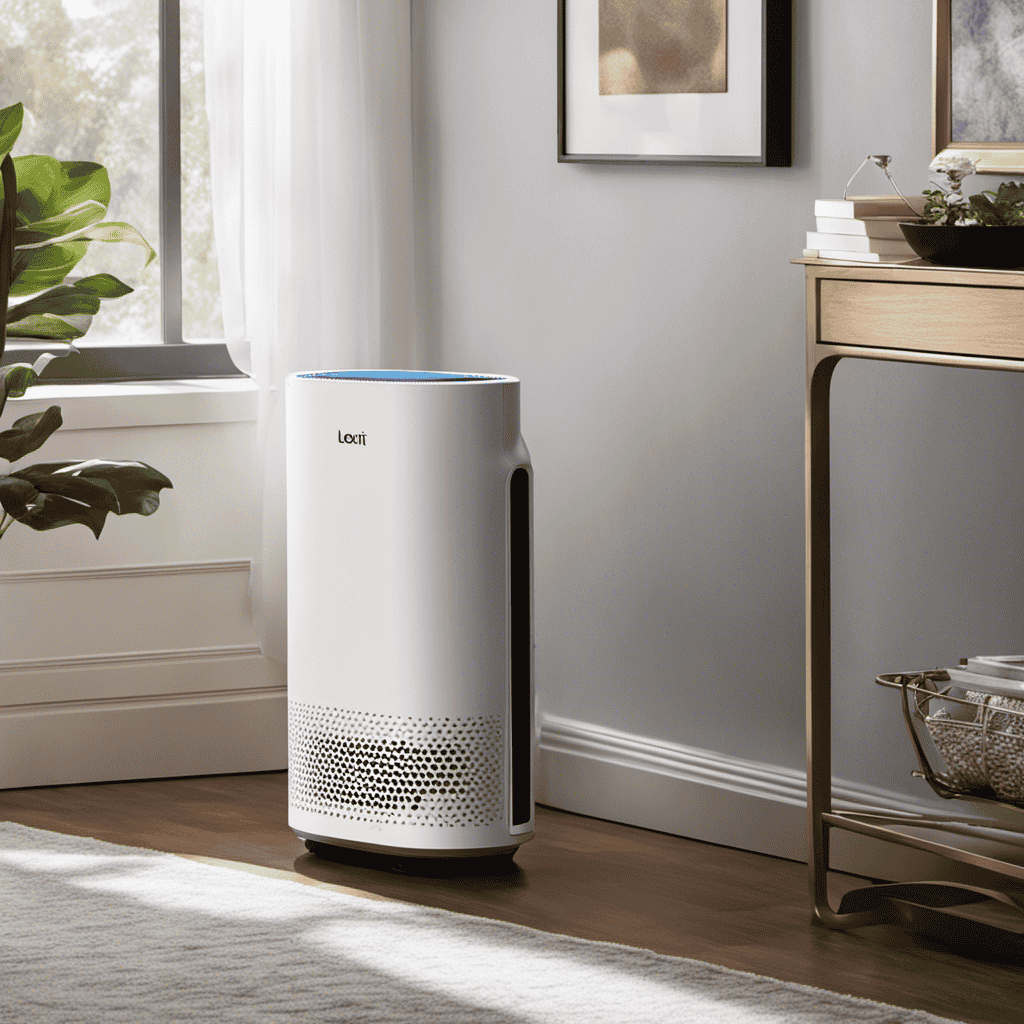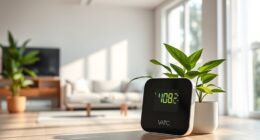When choosing between portable and whole-house air purifiers, consider your specific needs. Portable units are affordable and easy to set up, ideal for targeting specific rooms. They effectively capture 99.97% of particles but might require multiple devices for larger areas. Whole-house systems integrate with your HVAC, offering extensive coverage and consistent air quality. Although they come with higher upfront costs and require professional installation, they're more efficient in the long run. Assess your home size and air quality concerns to make the best choice for your situation. You'll find even more insights to help you decide.
Key Takeaways
- Whole-house air purifiers integrate with HVAC systems, providing extensive coverage and consistent air quality improvement throughout the entire home.
- Portable air purifiers are more affordable and easy to set up, ideal for localized air quality enhancement in specific rooms.
- Whole-house systems typically have higher upfront costs ($1,500 to $3,500) but may lead to long-term savings through energy efficiency and lower maintenance costs.
- Portable units use HEPA filters and require frequent filter replacements (every 3 to 6 months), potentially increasing long-term expenses.
- Assess your home size and air quality needs; whole-house systems suit larger areas, while portable units target specific spaces effectively.
Understanding Air Purification Systems
When it comes to improving your indoor air quality, understanding the different types of air purification systems can really make a difference.
You'll typically find two main categories: whole-house air purifiers and portable air purifiers. Whole-house systems integrate into your existing HVAC setup, providing extensive coverage throughout your home. They feature advanced filtration systems with a larger surface area than standard HVAC filters, and often include UV technology to tackle bacteria and mold.
Additionally, using ozone air purifiers can complement these systems by effectively eliminating allergens and odors, especially in spaces with persistent air quality issues.
On the other hand, portable air purifiers are designed for specific rooms, making them perfect for localized air quality improvement. These units use high-quality HEPA filters that capture 99.97% of particles as small as 0.3 microns, which is great for targeted areas, but they do have limited coverage.
When choosing an air purification system, consider the upfront costs and installation requirements. Whole-house purifiers generally require professional installation and come with higher initial costs, while portable units are more affordable and user-friendly.
However, keep in mind that portable systems may lead to higher long-term maintenance costs. Understanding these differences will help you make the right choice for your needs.
Whole-House Air Purifier Insights
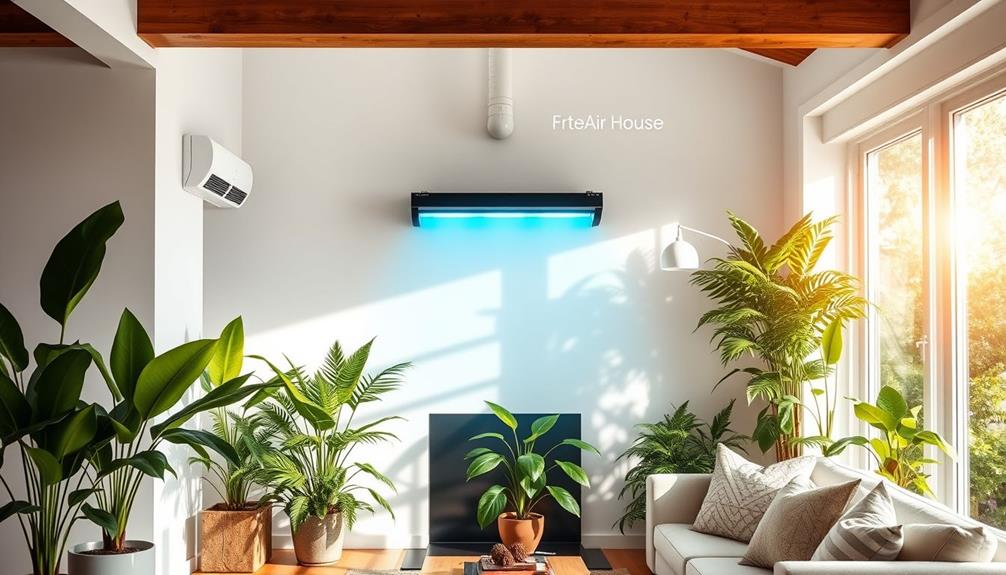
When considering a whole-house air purifier, you'll need to weigh the installation complexity against the potential benefits.
While the initial cost can be significant, many homeowners find that improved efficiency and lower maintenance costs make it worthwhile.
Additionally, many home security systems can be integrated with air purification systems to enhance indoor air quality while ensuring safety and peace of mind, as highlighted in the importance of home security systems.
Understanding these factors can help you make an informed decision for your home's air quality.
Installation Complexity
Installing a whole-house air purifier can be a complex task that requires professional expertise. Unlike portable units that just need to be plugged in, whole-house air purifiers are integrated directly into your existing HVAC system. This means the installation complexity is considerably higher, as professionals must guarantee compatibility with your home's layout and HVAC design.
Here's a quick comparison of installation aspects:
| Feature | Whole-House Air Purifiers |
|---|---|
| Installation Requirement | Professional installation |
| Complexity Level | High |
| Integration with HVAC | Vital |
| Time for Installation | Several hours to days |
| Compatibility Considerations | Must match home layout |
Having a trained technician install your system is essential for maximizing filtration efficiency and maintaining your HVAC performance. They'll navigate any challenges related to your home's specific design, guaranteeing that your whole-house air purifier functions effectively. Skipping professional installation can lead to inefficiencies and potential damage to your HVAC system, making it a worthwhile investment for ideal air quality.
Cost and Efficiency
Investing in a whole-house air purifier can seem intimidating due to its upfront costs, which typically range from $1,500 to $3,500. While this is a considerable investment compared to portable units, it's crucial to evaluate the long-term benefits.
Whole-house air purifiers require professional installation, which adds to the initial expense but guarantees proper integration with your HVAC system, maximizing efficiency. Additionally, many homeowners find that this type of system enhances overall home comfort and air quality, making it a worthwhile investment for those with allergies or respiratory issues.
One of the key advantages of a whole-house air purifier is its ability to enhance HVAC efficiency. By reducing dust and debris buildup, these systems can improve airflow, potentially lowering your energy bills over time. Many whole-house systems come with washable filters, which can greatly cut down on long-term maintenance costs. Unlike portable units that often need frequent filter replacements, a whole-house solution can save you both time and money.
Ultimately, while the upfront cost of a whole-house air purifier is higher, it can lead to considerable long-term savings. By minimizing the need for multiple portable units and their associated maintenance, you'll likely find that the investment pays off in both efficiency and cost-effectiveness.
Portable Air Purifier Features
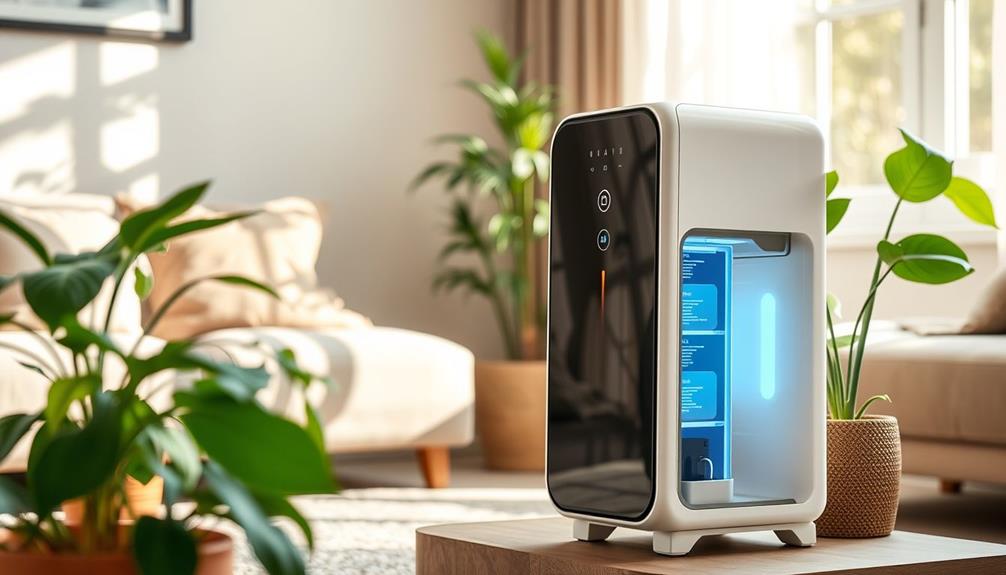
When you consider portable air purifiers, you'll notice several key attributes that make them effective for improving air quality in specific areas.
Their compact design and high-quality HEPA filtration make them ideal for situations where you need targeted air purification.
Additionally, they can be a great option for homes with pets, as dog health and nutrition can be greatly improved by reducing allergens in the environment.
However, it's crucial to weigh their usage scenarios against the potential need for multiple units and regular filter replacements.
Key Attributes of Portables
Portable air purifiers come packed with features designed for effective air quality improvement in various settings. One of the standout features is the high-quality HEPA filtration, which captures 99.97% of particles that are 0.3 microns or larger. This means you can trust these devices to considerably reduce allergens and pollutants in your immediate environment.
Many models also offer additional filtration technologies, such as activated carbon filters, which can help eliminate odors and volatile organic compounds (VOCs) from the air, making them a great choice for improving indoor air quality key factors in choosing a home cleaning service.
Their compact design is another key attribute, making it easy for you to transport them between rooms. If you notice higher pollution levels in a specific area, you can quickly move your portable unit to target that space.
Additionally, many portable models require no professional installation, allowing for a simple setup that's perfect for renters or those in temporary living situations.
While they often come with a lower upfront cost compared to whole-house systems, keep in mind that portable units may lead to higher long-term expenses due to frequent filter replacements.
They're effective in confined spaces, but remember that their coverage areas are limited, so you might need multiple units to achieve thorough air quality improvement throughout your home.
Ideal Usage Scenarios
A portable air purifier excels in scenarios where localized air quality improvement is essential. If you're looking to enhance air quality in specific rooms like bedrooms, living areas, or home offices, a portable unit is your best bet. Their compact design lets you easily transfer them between rooms, making it simple to target areas with higher pollution levels or where people gather.
| Usage Scenario | Benefits |
|---|---|
| Bedrooms | Reduces allergens for better sleep quality. |
| Living Rooms | Addresses odors and airborne debris during gatherings. |
| Home Offices | Improves focus by minimizing allergens and pollutants. |
| Small Apartments | Offers affordable air quality solutions without installation hassles. |
| High-Pollution Areas | Provides immediate relief in specific spaces, unlike a whole-house air purification system. |
Portable air purifiers, equipped with HEPA filters, capture 99.97% of particles, making them effective in enhancing air quality where it matters most. They're generally more budget-friendly, ideal for renters or anyone needing quick, localized air purification solutions.
Advantages of Whole-House Systems
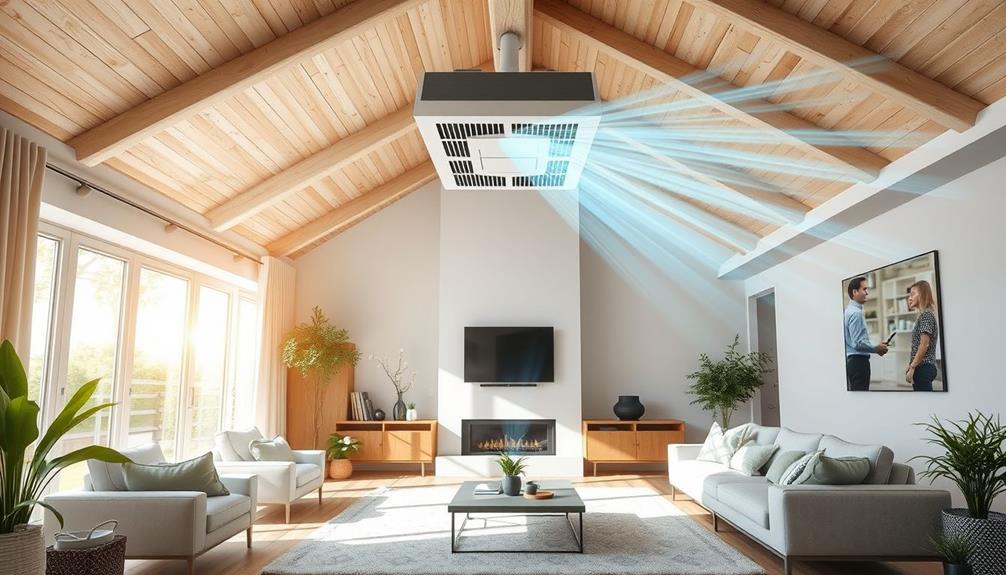
While many people consider portable air purifiers for their convenience, whole-house systems offer compelling benefits that can enhance your home's air quality. Whole House Air Purifiers are designed to filter air throughout your entire living space, ensuring consistent air quality without the hassle of managing multiple units.
By integrating seamlessly with your existing HVAC system, these systems greatly reduce airborne pollutants, leading to a healthier environment for you and your family. Additionally, energy-efficient systems like heat pumps can further improve indoor air quality while also reducing energy consumption, making them an excellent complement to whole-house purifiers heat pump benefits.
Air quality experts often recommend whole-house systems because they feature advanced filtration technologies, like HEPA filters, which capture particles as small as 0.3 microns with an impressive efficiency of 99.97%.
This level of filtration not only improves your indoor air quality but also boosts HVAC systems effectiveness. By preventing dust and debris from accumulating, whole-house purifiers can help your HVAC system run more efficiently, ultimately lowering your energy bills and extending the system's lifespan.
Many whole-house air purifiers also include UV light technology, effectively eradicating harmful bacteria and viruses.
This added layer of protection contributes to a healthier living space, making whole-house systems a smart investment for your home's air quality needs.
Benefits of Portable Purifiers

When you need quick and effective air quality improvement, portable air purifiers excel at delivering targeted relief in specific areas of your home. With high-quality HEPA filtration, these devices capture 99.97% of particles sized 0.3 microns or larger, making them perfect for tackling dust, pollen, and pet dander right where you spend your time.
Additionally, investing in a well-draining soil mix can enhance your indoor plant air quality, contributing to a healthier living environment. Their compact design allows you to easily move them between rooms, so you can focus on areas with higher pollution levels or unpleasant odors. This mobility is especially beneficial for renters or those in temporary living situations, as portable purifiers are generally more affordable upfront than whole-house systems.
While they work wonders in frequently used spaces, it's essential to recognize that you might need multiple units for larger areas to achieve thorough air purification throughout your home.
Be mindful of ozone emissions, as some portable air purifiers can produce ozone, which may affect sensitive individuals. Choosing models that are certified ozone-free will enhance your air quality without compromising your health.
Cost Comparisons for Air Purifiers
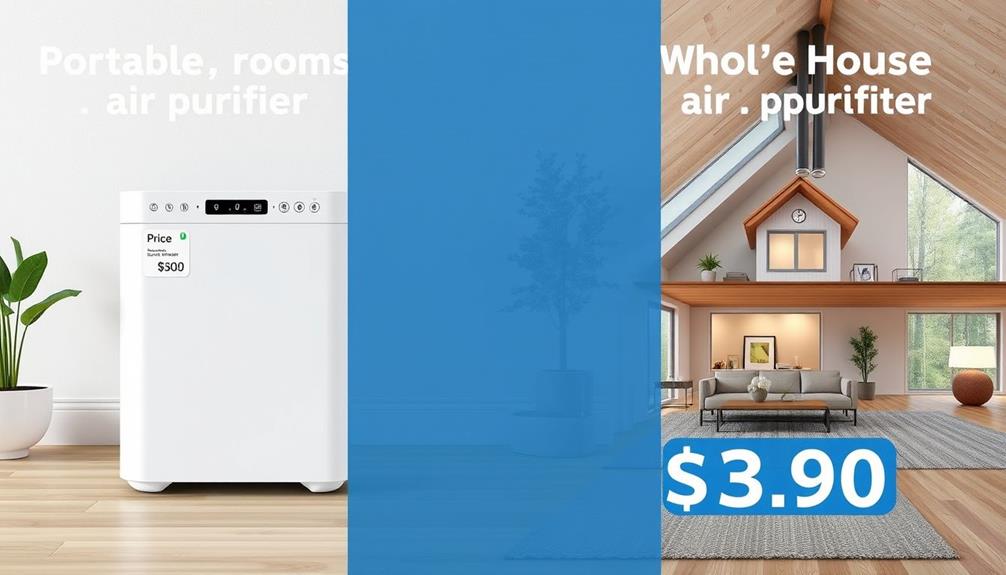
Portable air purifiers offer an affordable way to improve indoor air quality, but their upfront costs can be misleading when evaluating long-term expenses. While you might find portable air purifiers priced between $100 and $500, the total cost of ownership can quickly add up.
Additionally, many portable models now include advanced features like smart technology that can enhance their effectiveness. Here are three key cost comparisons to evaluate:
- Initial Investment: Whole-house systems range from $1,500 to $3,500, including installation, while portable air purifiers have a lower starting price but may require multiple units for effective coverage.
- Filter Replacement Costs: Portable systems often need frequent filter changes, leading to ongoing costs over time. In contrast, whole-house systems generally use washable filters, reducing maintenance expenses.
- Energy Efficiency: Whole-house systems can enhance HVAC efficiency, potentially lowering your energy bills and offsetting their higher initial investment. Portable units may not provide the same energy savings, especially if you run multiple units.
When weighing your options, evaluate these factors carefully. The lower upfront costs of portable air purifiers might seem appealing, but whole-house systems often lead to greater long-term savings and efficiency.
Effectiveness of Air Filtration
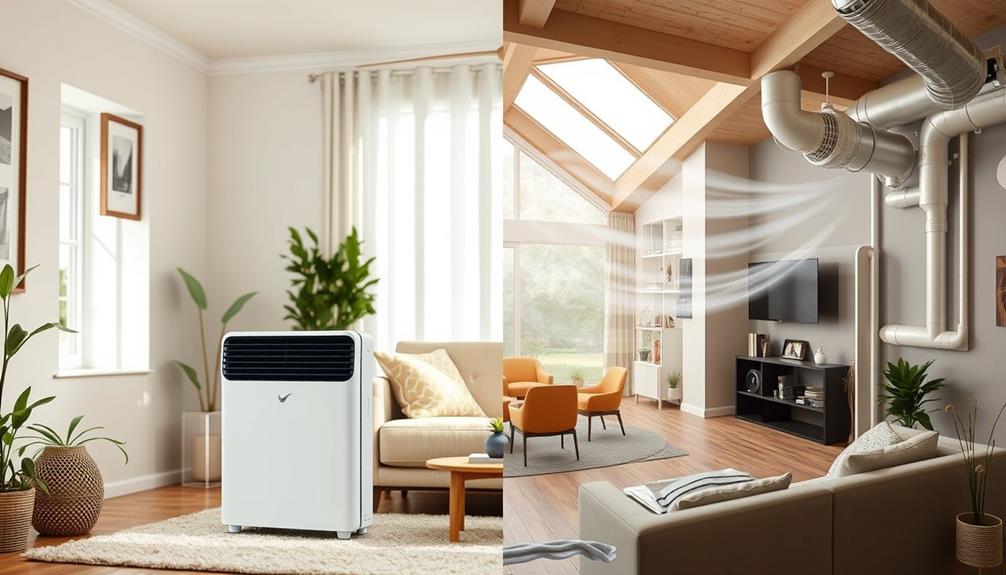
Improving indoor air quality hinges on the effectiveness of your air filtration system. When considering your options, it's vital to understand how well each system performs.
Whole-house systems integrate directly into your HVAC system, guaranteeing consistent air quality improvement throughout your entire home. They boast larger filter surface areas, often ten times greater than standard HVAC filters, which enhances their filtration capabilities and effectiveness in capturing pollutants.
Additionally, regular maintenance of your HVAC system, including filter changes, can further improve the overall performance of whole-house air purifiers and guarantee ideal air quality in your home. For those relying on gas appliances, it's also essential to guarantee proper ventilation during use, as this can impact indoor air quality as well importance of HVAC maintenance.
On the other hand, high-quality portable air purifiers typically feature HEPA filtration, effectively capturing 99.97% of particles that are 0.3 microns or larger. They do a great job at enhancing air quality in specific areas, but if you have a larger space, you might need multiple units to achieve similar effectiveness as a whole-house system.
Moreover, whole-house systems can incorporate ultraviolet technology to eliminate bacteria and mold, providing robust protection against harmful microorganisms in your air.
While portable units can target localized issues, they may struggle with odors or pollutants within your ductwork—areas where whole-house systems excel. Understanding these differences will help you choose the right air filtration solution for your needs.
Maintenance for Air Purification Units
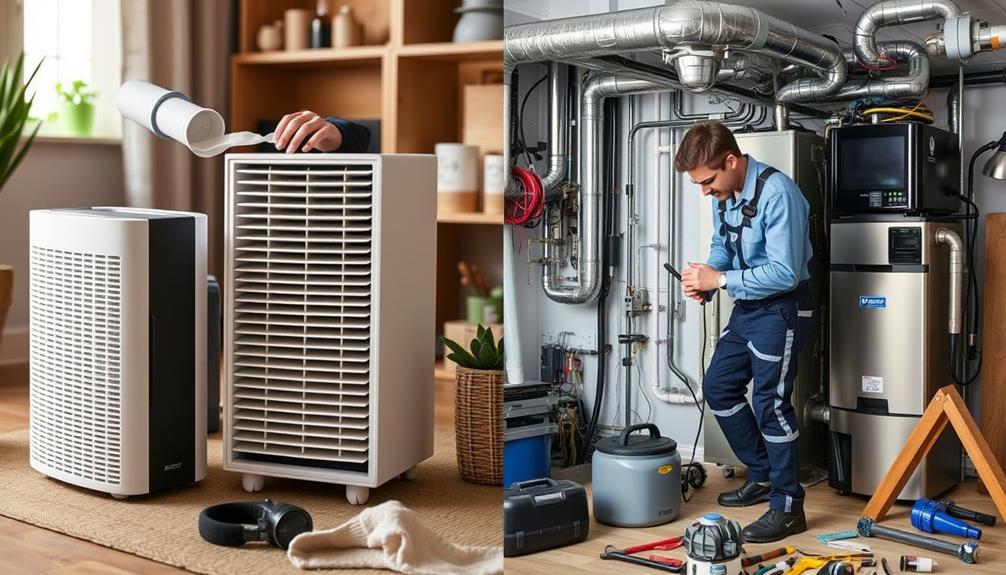
Maintaining your air purification unit is essential for keeping your air quality high. Regular maintenance guarantees that the unit operates efficiently and effectively.
You'll need to think about how often to replace filters, and it's wise to follow some cleaning tips to secure peak performance. Implementing a methodical approach to maintenance, similar to the best practices in software quality assurance, can help you stay on track.
Depending on your system, you might also want to look into professional service recommendations for more thorough upkeep.
Filter Replacement Frequency
Regularly changing filters is vital for ensuring peak performance in air purification units. The filter replacement frequency varies greatly between portable air purifiers and whole-house air purifiers.
While portable units typically require filter replacements every 3 to 6 months, this can increase due to factors like high pollution, pets, or smoking. In contrast, whole-house systems usually employ advanced filter technology, allowing for replacements every 6 to 12 months.
Maintaining good indoor air quality is essential, particularly for those with respiratory issues, as the importance of public health awareness in disease prevention can't be overstated.
Here are three key considerations for filter replacement frequency:
- Usage: The more you use your portable air purifier, the more frequently you'll need to change its filters.
- Air Quality: If you live in an area with high pollution or have indoor pets, expect to replace filters more often in portable units.
- Filter Type: Whole-house air purifiers often use HEPA filters designed to last longer and reduce clogging, which can save you time and money on maintenance.
Neglecting timely filter changes can lead to decreased air quality and system efficiency, so always adhere to the manufacturer's guidelines for best performance.
Cleaning and Maintenance Tips
Air purifiers require consistent cleaning and maintenance to function effectively over time. For portable air purifiers, it's essential to check and replace the filters every 3 to 6 months. This guarantees peak air quality and efficiency.
In contrast, whole-house air purifiers typically need filter changes every 6 to 12 months, depending on usage and filter type.
Don't forget about your HVAC system; dust and debris can accumulate in the ductwork. Clean your entire system and ducts annually to boost the performance of whole-house air purifiers.
For portable units, always place them in well-ventilated areas away from obstructions. This placement maximizes airflow and filtration effectiveness.
Also, consult the manufacturer's guidelines for specific maintenance recommendations. For example, some whole-house systems may require UV light bulb replacements approximately every 12 months.
Keeping up with these maintenance tasks not only enhances air purification but also extends the life of your units. By prioritizing cleaning and maintenance, you'll enjoy cleaner air and a healthier living environment.
Professional Service Recommendations
Annual professional maintenance for air purification units can greatly enhance their performance and longevity. By scheduling regular check-ups with certified HVAC professionals, you guarantee peak efficiency and improved indoor air quality in your home.
Here are three key reasons to invest in professional services:
- Thorough Inspections: Professionals can inspect your air purification system for any potential issues, helping you identify problems before they turn costly.
- Filter Replacements: They'll remind you when it's time to replace HEPA filters—typically every 6 to 12 months—ensuring your unit runs effectively and maintains high filtration standards.
- Ozone and MERV Checks: For portable units, pros can check for ozone emissions and confirm that your air purifier is operating at its specified MERV ratings, which is vital for effective air filtration.
Selecting the Right System
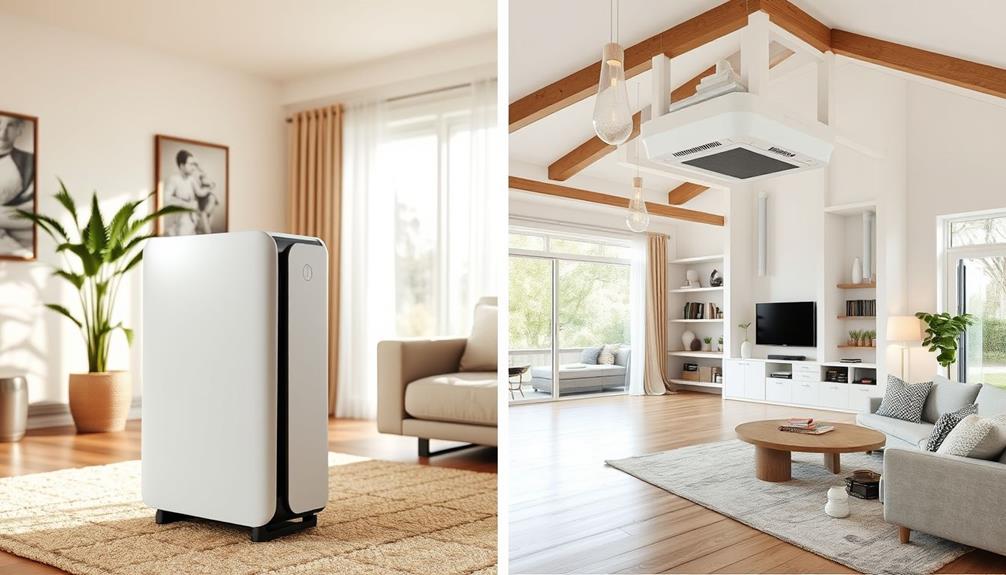
When choosing the right air purifier system for your home, it's crucial to assess your specific needs and living space.
If you have a larger area, consider whole-house air purification systems, as they effectively cover extensive square footage. For smaller or specific rooms, portable units might be the better option.
Next, think about your air quality needs. If you're sensitive to allergens or odors, a targeted portable unit could provide immediate relief.
However, if you want extensive coverage, a whole-house system would be more suitable.
Don't forget to research the type of filters used in each system. HEPA filters are highly efficient in capturing airborne particles, making them an excellent choice for both portable and whole-house air filtration systems.
Enhancing Indoor Air Quality
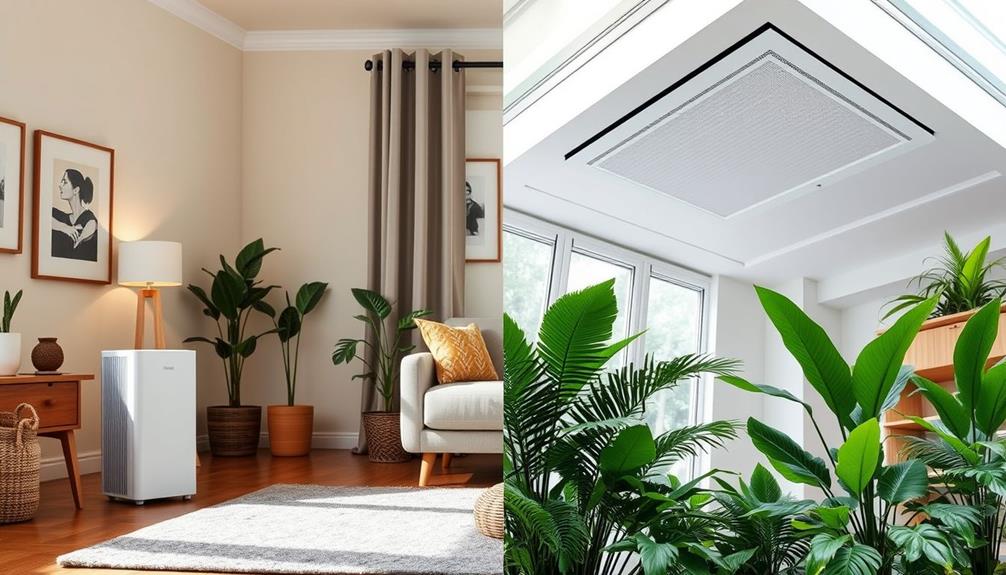
Improving indoor air quality is essential for maintaining a healthy living environment. You have two main options: portable air purifiers and whole-house air purification systems. Each serves a unique purpose in enhancing the air you breathe, but understanding their differences can help you make the right choice.
Here are three key factors to evaluate:
- Coverage Area: Whole-house systems filter air throughout your entire home, ensuring consistent air quality across all rooms. Portable units, on the other hand, are effective in localized areas, capturing 99.97% of particles 0.3 microns or larger.
- Maintenance Needs: Whole-house air purifiers typically require less frequent filter changes due to their larger filter surface area, while portable units may need more regular upkeep.
- Air Filtration Efficiency: Look for systems with a MERV rating of at least 8. This rating effectively filters common indoor pollutants, such as dust and mold spores.
Conclusion
In the end, choosing between a portable or whole-house air purifier might feel like a simple task, but it's anything but straightforward. You might think a whole-house system is the ultimate solution, yet it can leave you gasping in a room without coverage. Conversely, a portable purifier could become your best friend, yet it's limited to a single space. So, while you're deciding, remember: sometimes the smallest solutions can have the biggest impact on your air quality.
